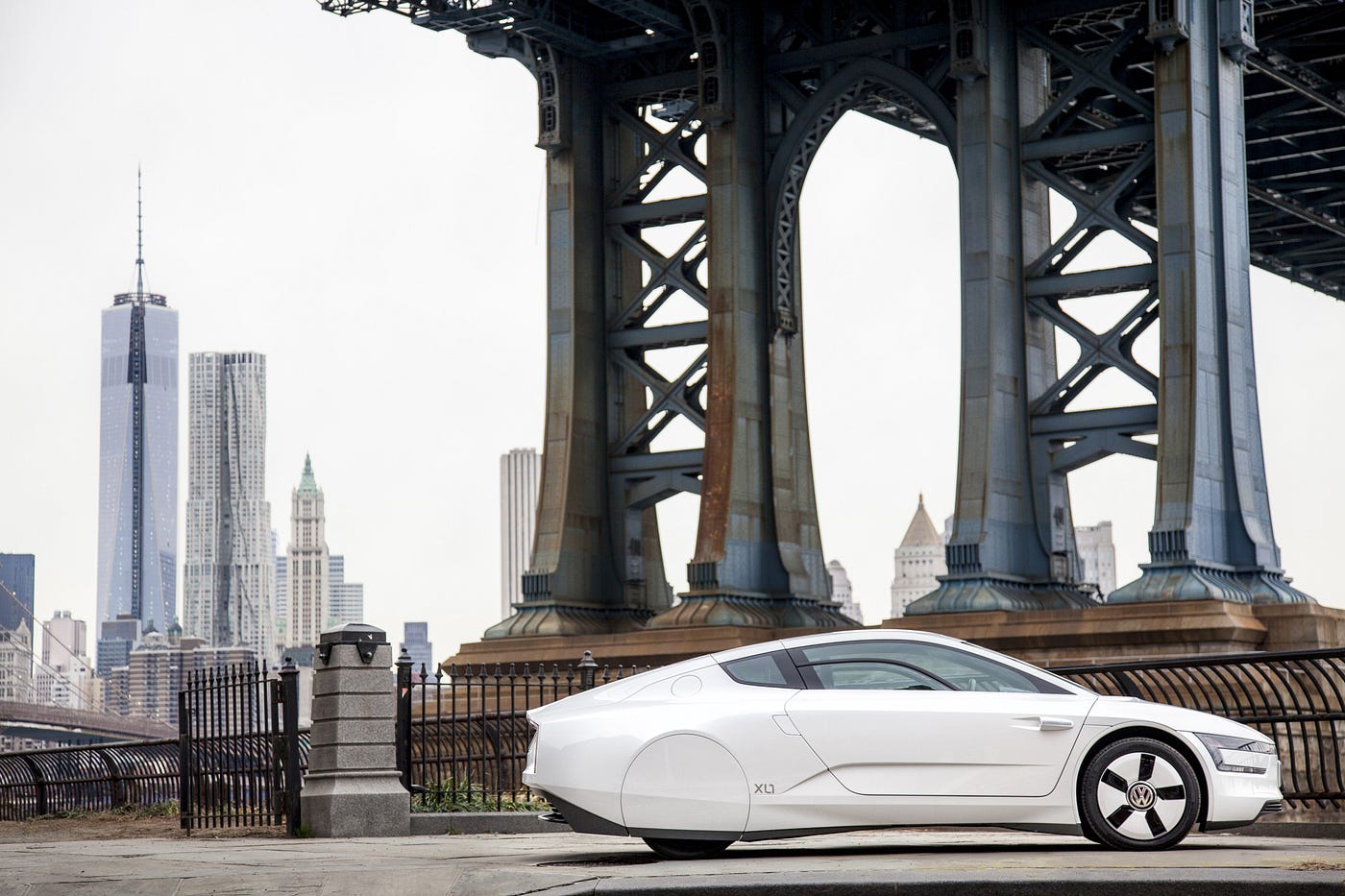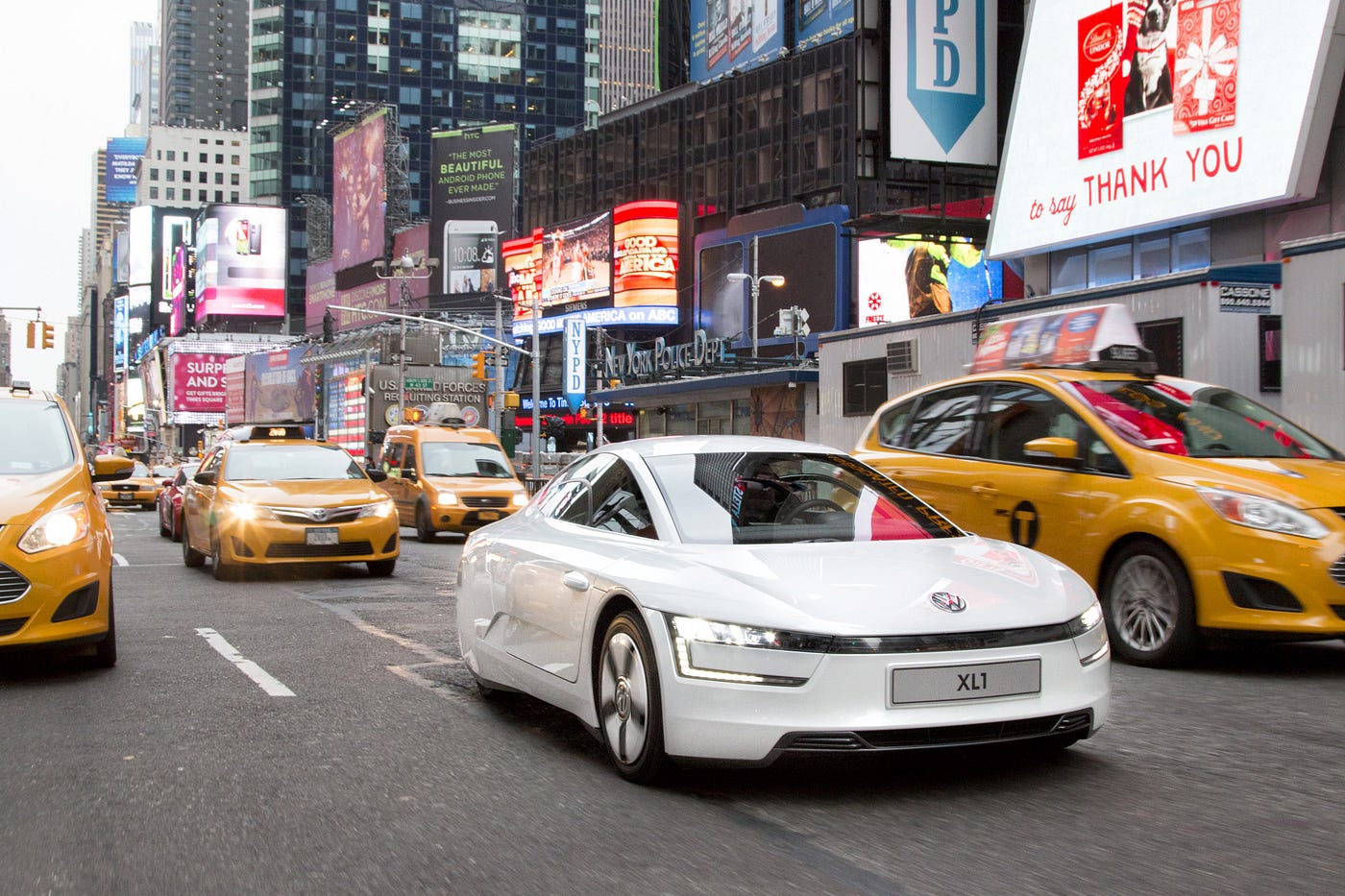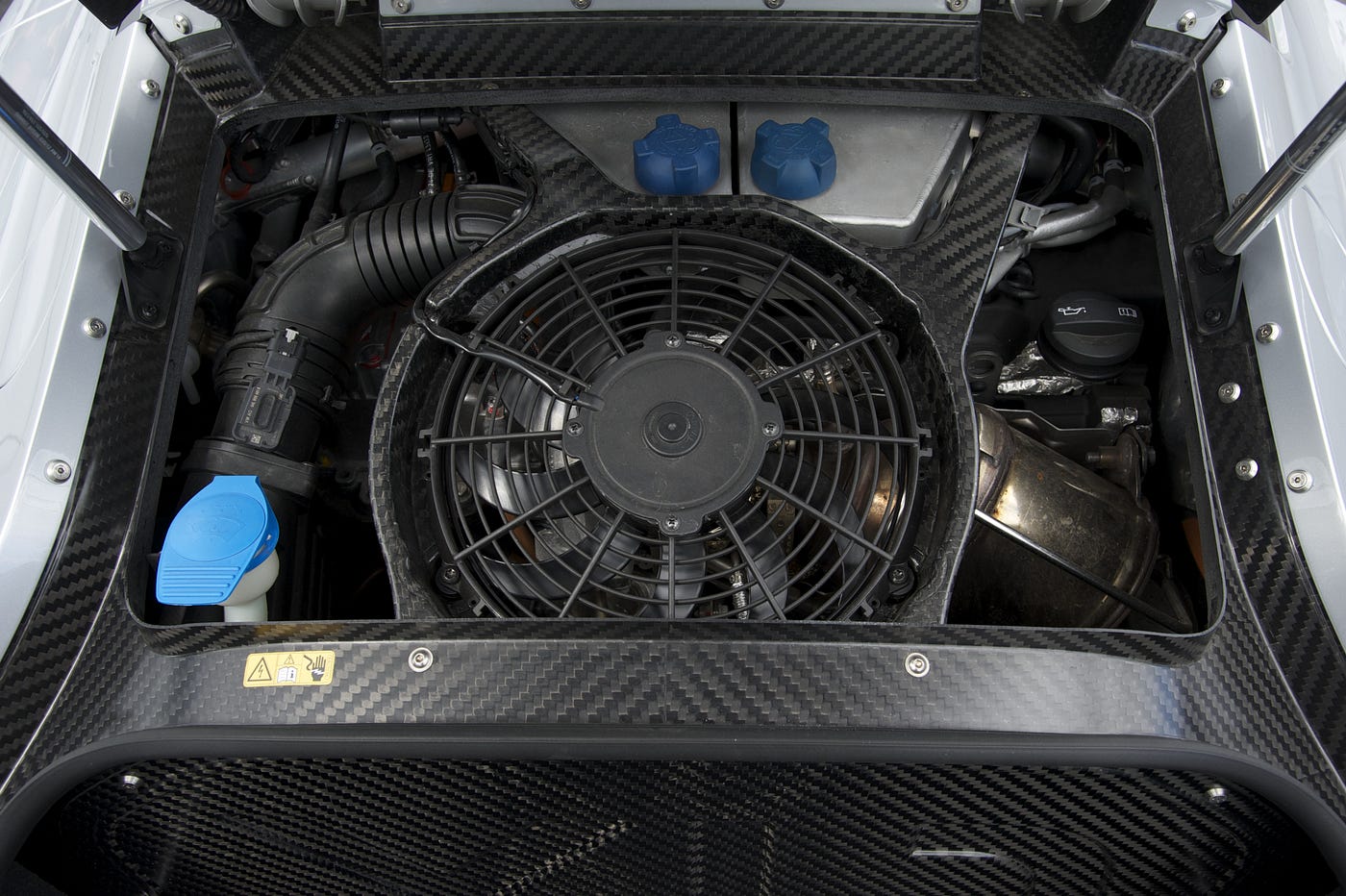The Hypercar Lives: Meet VW’s XL1
RMI
followers and auto buffs often ask, ‘What happened to the hypercar?’
With the release of VW’s impressively fuel-efficient and strikingly
similiar XL1, the world now has an answer.
Original link: https://medium.com/solutions-journal-summer-2014/the-hypercar-lives-meet-vws-xl1-97603e97612f

When
VW released the European fuel economy ratings for its new,
limited-production XL1 passenger car last summer, you could almost hear
the automotive world’s collective jaw drop. The XL1 came in at a
staggering 313 miles per Imperial gallon of diesel. That’s the
efficiency equivalent of more than 230 miles per U.S. gallon of
gasoline. At a time when the 2014 model of the best-selling vehicle in
the United States for more than three decades — Ford’s F-150 pickup
truck — gets an EPA-rated 23 mpg highway, and the average for all model
year 2013 light-duty vehicles sold in the U.S. was just 24.6 mpg, VW had
moved the decimal point an entire place to the right.
Engineering leadership and platform fitness
The
XL1 is named for its engineering goal: develop a production car that
can drive 100 kilometers on 1 liter of fuel (235 miles per U.S. gallon).
That was the charge in 1999 to VW engineers by the company’s visionary
then-chairman, Ferdinand Piëch, who is Ferdinand Porsche’s grandson and
chair of VW’s supervisory board today. “We built the Bugatti and now the
XL1,” says Mark Gillies, manager of product and technology
communications for VW of America. “Both use extreme technology to
achieve almost opposite ends of the [performance] spectrum.”
The
XL1’s tiny 2.6-gallon diesel-fuel tank can fuel average driving for
more than 310 miles, thanks to a combination of strategies that RMI
collectively calls platform fitness. That’s the key to the Hypercar
concept developed by RMI chief scientist Amory Lovins in 1991 and
evolved by RMI’s Hypercar Center through the 1990s. Hypercars integrate
ultralight weight, superior aerodynamics, low-rolling-resistance tires,
and a downsized and superefficient electrified powertrain. For example,
VW’s XL1 weighs just 1,753 pounds. How? “We used mixed lightweight
materials to bring out their best performance in their respective places
in the vehicle,” explains Dr. Volker Kaese, VW’s project manager for
the XL1. High-temperature-tolerant steel is used in the powertrain.
Lighter, more flexible aluminum forms the chassis and crush zones.
Polycarbonate side panels save weight and allow sleeker shapes. And the
passenger cell is a carbon-fiber monocoque.
Then
there’s the XL1’s astonishing aerodynamic drag coefficient. Lower is
better, and the XL1’s 0.189 is the best ever in a production car. By
comparison, a sleek and streamlined 2014 Corvette Stingray has a drag
coefficient of 0.29 and Ford’s popular F-150 is around 0.40. The XL1
shaves drag everywhere it can, covering the rear wheels and replacing
protruding side-view mirrors with low-profile, rear-facing cameras
displayed on a dashboard screen.
Even
before the first XL1 rolled off the production line, some were quick to
point out the striking parallels between the Hypercar concept specs of
the early 1990s and the real-world specs of today’s production XL1. “The
XL1 is a hypercar in the way that might make Amory Lovins smile,” wrote
High Gear Media’s Bengt Halvorson, in a piece that ran in the Washington Post. “That’s
a nod to one of the creators of the original 1990s Hypercar project
from Rocky Mountain Institute.” Similarly, automotive writer David
Herron in Torque News noted, “the VW XL1 is the embodiment of the hypercar concept developed by Amory Lovins years ago.”
Besides
Lovins himself, no one knows this better than Michael Brylawski.
Currently the founder and CEO of Vision Fleet Capital, which works on
clean vehicle adoption, he cofounded RMI’s sustainable transportation
practice and later led strategy for RMI spinoffs Hypercar, Inc., its
successor Fiberforge Corporation, and Bright Automotive. “When I saw the
XL1 from VW, the specs looked quite similar to where Amory was
predicting well over 20 years ago that vehicle design could go,” he
explains. “The XL1 is the purest form of the Hypercar [on the market
today]. The similarities are exceptional.”
From Hypercar concept to VW reality
RMI’s
Hypercar started in 1990 with a $50,000 seed grant from the Nathan
Cummings Foundation to “get Amory to think about cars.” The resulting
paper, “Advanced Light Vehicle Concepts,” shocked the National Research
Council’s auto-efficiency symposium, says Lovins. Don Runkle, then GM’s
head of advanced engineering, took Lovins to lunch, and on a handshake,
launched a fruitful two-year process of mutual education.
To say that Lovins, RMI, and Hypercar made a splash in the auto world would be an understatement. The British magazine Car named
Lovins the 22nd most powerful person in the global automotive industry
(and the only outsider). The Hypercar concept won the ISATA Nissan Prize
and a World Technology Award — followed by another to Hypercar, Inc. In
1993, after two years’ validation with the industry, RMI put the
Hypercar concept into the public domain so nobody could patent it and to
encourage competition leveraging its ideas, while RMI’s for-profit
spinoffs sought to commercialize technologies outside automakers’
comfort zone and raise the competitive pressure.
By the first half of the 2000s, you could read about the Hypercar everywhere from Automobile magazine to the Wall Street Journal to Environmental Health Perspectives. But
a true Hypercar had yet to leap from the drawing board to the streets.
“The roadmap was right, but the distance underestimated,” Brylawski says
today.

Indeed,
many of Lovins’s predictions have come to pass. Two decades ago he
claimed regenerative braking could yield 70 percent efficiency when
automakers balked at the idea of exceeding 30.
Today’s electric vehicles, including the Chevy Volt and Tesla Model S, respectively get 70+ and 80 percent. Meanwhile, the XL1’s specs are an eerily close match with Lovins’s early Hypercar predictions for achievable rolling resistance, aerodynamic drag, and more. (Unfortunately, estimates of fuel economy can’t be directly compared between the Hypercar and XL1 due to differences in their number of seats, U.S. vs. European test cycles, and changes in modeling and test cycle protocols, but both are far into triple digits.)
So
if the Hypercar concept is now emergent reality, why aren’t more
Hypercars on the road? “There’s a lot of hard work that goes between the
idea and the execution,” says Brylawski. And that’s where
VW’s XL1 is really notable. It combines an electrified hybrid
powertrain, lightweight carbon fiber and other materials, and low
aerodynamic drag and rolling resistance, bringing the Hypercar and other
1990s concepts like it — such as GM’s 1991 Ultralite — from drawing
board to driver’s seat. Lovins, for his part, is thrilled — he would
love to be VW’s first U.S. XL1 customer, he says.
The fuel-efficient road ahead
For
all the similarities between Hypercar and XL1, there is at least one
major point of departure: cost. The Hypercar was always meant to be
competitively priced, but with a sticker price of $150,000, VW’s XL1
certainly is not. Its production run is just 250 copies — a niche,
novelty vehicle for aficionados. “It’s something of a one-off,” says
VW’s Gillies. “The market is effectively limited for [such an expensive]
small economy car.”
But
a high-volume car was never VW’s goal. The XL1 was a proof of concept,
says Gillies, to “show the production feasibility; that VW has the
vision and drive to get it through to production. It’s one thing to do a
concept, but another to show you could actually build the thing.” Its
innovations will doubtless inform other models.

Despite
XL1’s eye-popping mpg rating, VW might have left some efficiency on the
table. Lovins notes that Toyota’s 2007 1/X concept car, also a plug-in
hybrid, had four seats and the interior volume of a Prius, but weighed
only 926 pounds, so even a production-ready version would probably weigh
less than the two-seat XL1. “We’re seeing a lot of partially executed
solutions,” says Jerry Weiland, the GM veteran who leads RMI’s
transportation practice. “Different automakers have done bits and pieces
[of the Hypercar concept], but no one has put the whole thing
together.”
Equally surprisingly, the XL1 may actually take efficiency further than
needed. RMI senior associate Jonathan Walker explains: “VW had a
different goal than we do. Their goal was to make a 235-mpg car. In my
opinion, you don’t need that,” he says. “RMI’s goal is get off carbon
and oil. A 100 mpg car gets you there.” RMI’s Reinventing Fire analysis,
he notes, can fuel its efficient vehicles, some at just half XL1’s
efficiency, with any mixture of electricity, hydrogen, and advanced
biofuels but no oil. “The added capital and cost of going for XL1 levels
of efficiency is not worth it,” Walker says. “You start getting
diminishing returns.” In other words, more modest but still radically
improved fuel efficiency can yield an affordable Hypercar that doesn’t
carry an XL1 price tag.
Runkle’s theory of economic gravity
“Amory
gets full credit for putting these concepts on the table more than 20
years ago,” says Weiland. “But by now, the automakers have developed and
productionized what they saw fit. If they’re not doing something,
there’s probably a somewhat rational reason.” One of those reasons is
federal fuel economy standards. Until recently, U.S. consumers haven’t
been especially concerned about mpg in their car-buying decisions, so
automakers have mostly done just enough to meet corporate average fuel
economy (CAFE) requirements.
As
Walker notes, those requirements, recently stiffened to 54.5 mpg for an
automaker’s fleet by 2025, still might not move the needle. Many
automakers can make more money paying modest penalties and selling
gas-guzzlers than they can complying. Also, more-efficient hybrids and
electric vehicles help automakers’ fleets meet the CAFE average standard
while still including inefficient SUVs and pickup trucks.
But
if CAFE standards are insufficient, that puts the ball squarely back in
the court of economics. And Don Runkle has something to say about that.
Runkle
is now executive chairman of EcoMotors, a firm pioneering
superefficient internal combustion engines (which Lovins thinks could
weigh far less than the XL1’s plug-in diesel-electric hybrid). Before
EcoMotors, Runkle spent 30 years with GM, leading the Ultralite and
other early-1990s Hypercar-esque concepts. “I was always involved in
some attempt at extraordinary performance levels,” he says. “Sometimes
it was outright speed or acceleration or fuel efficiency. You’re pushing
the envelope. In terms of high performance — whether it’s acceleration
or top speed — you’re always trying to make sure you had the structural
integrity you needed at the lowest mass you could
handle” — simultaneously boosting efficiency.
Like
the Hypercar, his Ultralite team similarly pursued lightweighting,
rolling resistance, aerodynamics, and a downsized powertrain to develop a
sporty, 100-mpg, four-seat concept car. At some point, though, Runkle
argues that eking out more mpg comes at a cost. If cost is no object,
almost any level of performance — fuel economy or otherwise — is
possible. But cost is an object. He calls it his theory of economic gravity.
“In
a nutshell, it’s not hard to get high fuel economy. That’s a matter of
physics,” he explains. “What’s hard is to get a technology that saves
more than it costs. That’s economic gravity, where there’s a natural
incentive.” Automakers more or less all have a spreadsheet, Runkle says,
showing incremental efficiency gain vs. cost for a big portfolio of
technology options — electric steering, lightweighting with carbon
fiber, LED lights, lower-friction tires. Engineers start with the
cheapest options and work their way down the list until they’ve met
legal mpg requirements, he says.
“It’s
always good to do the Hypercars, the Ultralites,” says Runkle. “They
push the envelope. They help clarify the problem and show the promise.
Then you can focus more on trying to solve the cost issues.”
A Hypercar for the masses
There
is, of course, a very RMI way around the a la carte approach of
Runkle’s spreadsheet: whole-systems thinking. “That’s the challenge if
you’re only looking at single components versus a systems approach,”
says Brylawski. “It’s challenging running a multi-billion-dollar,
multi-million-unit auto company without some specializing,” Brylawski
continues. “That’s a barrier to more holistic approaches” like VW’s XL1
and BMW’s i3, not to mention RMI’s Revolution concept, an early 2000s
SUV designed by Hypercar, Inc. and two Tier Ones.
“What
Amory and RMI showed [with Hypercar] is that change is hard but you can
end up in a better place. But why change unless you have to?” That’s
the rub. Inertia is strong. “The extreme retooling required,
metaphorical and literal, hasn’t been compelling enough for automakers,”
argues Brylawski. “Not until recently have you had a global regulatory
and fuel price environment that makes it worthwhile” — and the threat,
proven by Tesla, of outcompeting incumbents by making better autos that
people will buy because they’re superior, not just because they’re more
efficient.
Now, with
automakers like VW leading the charge, and with manufacturing methods
like RMI’s Fiberforge spinoff (whose technology was sold last year to
German Tier One pressmaker Dieffenbacher), that could be changing. “Fast
forward to today,” Brylawski points out. “BMW has a car made largely
from carbon fiber. Toyota has a fuel cell car coming out. VW’s XL1 gets
hundreds of miles per gallon. We’re seeing a whole host of interesting
solutions that read pretty closely out of Amory and RMI’s playbook from
the early 1990s.”
Moreover,
from VW’s Jetta to Toyota’s Prius, automakers are offering multiple
efficient and electrified powertrain options: TDI clean diesel, hybrid,
plug-in hybrid electric, all-electric, and extended-range electrics like
the Chevy Volt. “It comes back to platform physics. That makes sense to
do first,” continues Brylawski. “The combination of platform fitness
and electrification is like peanut butter and chocolate creating a
Reese’s cup. It’s Amory’s holistic view, and that’s where VW and BMW are
ahead of the curve.”
“I
think XL1 will stimulate both VW and its competitors — as will BMW’s i3
and i8 — to develop families of diverse vehicles that increasingly
converge with our original Hypercar goals,” says Lovins, reflecting on
the Hypercar’s influence. “Our early-1990s expectations are now matched
by reality in such key areas as mass, drag, tire rolling resistance,
braking energy regeneration, and — even exceeding my early hopes — the
weight, cost, and performance of electric powertrains. Such advanced
vehicles are not only for the select, higher-price markets in which
they’re initially being introduced in Germany, but also ultimately for
mass markets.”
“It
takes a long time, but once you get these things into the market,
things start to accrete,” concludes Brylawski. “The Prius outsells every
SUV in America. Back in 2000 that was unimaginable.” We’re already, in
fact, seeing signs of further traction. Earlier this year BMW increased
production on its i3 by 43 percent to meet higher-than-expected consumer
demand, and is on track for total annual sales, at U.S. prices starting
around $40,000, to be nearly double initial forecasts.
From
VW’s pioneering XL1 to BMW’s i3 to even the aluminum-infused,
lighter-weight-but-still-built-Ford-tough F-150, Hypercar’s innovative
concepts live on.
Written by Peter Bronski, editorial director of RMI. Follow Peter on Twitter.
This article is from the Summer 2014 issue of Rocky Mountain Institute’s Solution Journal. To read more from back issues of Solutions Journal, please visit the RMI website.
